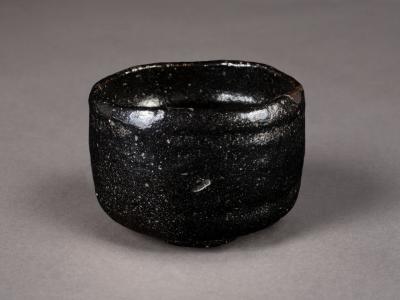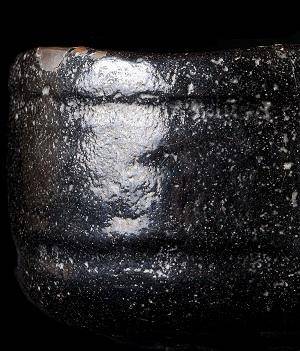
Black Raku Tea Bowl
3rd-7th generation of Raku family, Japan
1800s
3.625 in x 4.75 in
Gift of Ellen and Jack Ramsay Harris, 1993.12
Photograph © Denver Art Museum 2011. All Rights Reserved.
Until recently, the majority of raku [RAH-koo] ware was made by generations of the Raku family in Japan. This black tea bowl was most likely made by a member of the Raku family sometime during the 1800s, between the 3rd and 7th generations of the family. Raku wares are different from other Japanese ceramics because potters form the pieces by hand rather than on a potter’s wheel. Each bowl the raku potter makes shows signs of his fingers and hands. It’s almost as though the artist was communicating to you through the clay. After he is finished creating the shape of the bowl, the potter applies a glaze to the piece and fires it in a kiln at a low temperature. The potter of this bowl chose a very plain glaze that is all black. There are variations in the texture; some areas of the surface are slightly rough and pitted. The craftsman must have wanted to leave out decoration and make a bowl that was modest rather than showy; quiet rather than loud.
The making of raku ware was initiated by Chôjirô [CHO-jih-row] during Japan’s Momoyama period (1573-1615). Chôjirô was asked by the tea master Sen Rikyû [sen REE-kyoo] to make tea bowls for a tea ceremony. Chôjirô was presented with a seal bearing the Chinese character for “raku.” The term raku derived from the word Jurakudai, the name of a palace built by the leading warrior statesman of the time. “Raku” then became the name of the family that produced the ceramics. This is the only example in history of a family name becoming synonymous with the ceramics they produced. Raku is the most renowned of all tea ceremony ceramics, and the Raku family was highly respected for their skillfully crafted tea bowls and table wares. Now, many potters make raku ware.
The artist who made this bowl took into consideration how the bowl would be handled and viewed during a tea ceremony. Because the bowl is very plain, perhaps the artist was inspired by the idea of how attractive a bowl can be when it is very subtle. A bowl that is subtle has less obvious qualities that are very hard to notice. However, if a guest examines the bowl very carefully, he can see and feel the details. Maybe this artist wanted to challenge the people who drank from the bowl to pay very careful attention to its simpler qualities. The other thing that certainly inspired this artist was his knowledge of all the potters in the Raku family who had come before him. He was making a bowl in the same tradition as these earlier potters out of respect for their skill and design style.
The tea bowl is the centerpiece of the Japanese tea ceremony. Traditionally, a tea bowl has no handles and is made to be held in both hands. It is the most active of all tea utensils as it gets passed around to all of the guests. Each guest drinks out of the bowl and examines its shape, color, and texture before returning it to the host. Those who make tea bowls aim at making a bowl that will engage the senses of vision and touch, and small and subtle variations are often prized.
The ritual of serving tea involves a number of specific steps for the host and guests. It can last anywhere from twenty minutes to five hours and consists of two distinct stages, represented by the drinking of thick tea (about the consistency of white Elmer’s glue) and thin tea (about the consistency and frothiness of hot chocolate). Both types of tea are prepared by whisking green tea powder with water, but the powder used to make thin tea comes from plants that are younger than those used for thick tea, and more water is used in the preparation of thin tea.
When preparing for the ceremony, the host places a little mountain of powdered green tea inside a tea caddy or container. Once the ceremony begins, he removes the lid of the caddy and scoops a small amount of tea powder into a tea bowl, whisking it with hot water to create a bitter green tea. After the guests have finished their tea and the host has cleaned the utensils, the guests will often examine each item, noticing its color, shape, size, glaze, and texture. The utensils are handled with extreme care and reverence because they are often very valuable. The host chooses which containers to use based on who is attending the ceremony, the level of formality, the season, the time of day, and how each container will complement other utensils used.
Information about the Japanese tea ceremony can be found here.
Another tea bowl in the Denver Art Museum’s collection:
Two examples of tea caddies in the Denver Art Museum’s collection:
Ceramic Tea Caddy for Thick Tea
Natsume, Sun and Moon Thin Tea Caddy
Details

Glaze
Glaze is the shiny, glass-like coating that covers the surface of the bowl. Raku bowls are traditionally covered in a glaze that is made out of pulverized stone from the Kamo River in Japan. After the glaze is applied, the bowl is fired, a process that melts the glaze and turns it into a new substance—glass. When the bowl cools, the glaze hardens, making the bowl waterproof. The bowl is removed from the fire when it is red hot and the sudden temperature change causes the glaze to turn black. Raku tea bowls are almost always covered in monochrome black or red glazes.

Irregular Oval Mark
There is a distinctive mark on what is probably the front of the bowl, which was most likely made when the bowl was removed from the fire with tongs. This small irregularity was greatly admired.

Irregular Shape
The lip of the bowl is uneven and the sides are somewhat bumpy, indicating that the bowl was made by hand. This is another example of how the bowl embodies the Japanese belief that there is beauty in things that are simple and imperfect.
More Resources
A Tea Gathering at San Francisco's Urasenke Society
A discussion of Japanese tea culture and ceremony.
Raku Demonstration
A video of a Raku workshop, with demonstration of several Raku techniques.
Raku: Traditional Practice Informing Student Work
Students learn about and make Raku ceramics.
Websites
Raku Museum, Kyoto, Japan
Overview of Raku
Denver Art Museum, Asian Art
Denver Art Museum Asian Art Web Page
Denver Art Museum Wacky Kids
Denver Art Museum Web Page, Kids Books about Japan
Japan Fact Sheet: Tea Ceremony
Document summarizing the Japanese tea ceremony
Tea and the Japanese Tradition of Chanoyu Summary
Summary of book about the tradition of Chanoyu, including lesson plan outline and table of contents
Books
Sadler, A.L., Iwasaki Satoko, and Shaun McCabe. The Japanese Tea Ceremony: Cha-No-Yu. Boston: Tuttle Classics, 2008.
An exploration of one of Japan's greatest arts and details, the importance of the tea ceremony's history and traditions, its historical tea masters and its physical manifestations.
Speight, Charlotte F., and John Toki. Hands in Clay, An Introduction to Ceramics. Fifth Edition. New York: McGraw-Hill, 1999.
A good overall view of ceramic history and techniques. Heavily illustrated with examples of the diversity of ceramic artists creations. Good reference for ceramics students.
Pitelka, Morgan. Handmade Culture: Raku Potters, Patrons, and Tea Practitioners in Japan. Honolulu : University of Hawaii Press, 2005.
A comprehensive and cohesive study examining Raku, one of Japan's most famous arts, and a pottery technique practiced around the world.
Branfman, Steve. Raku: A Practical Approach. Radnor, PA: Chilton Book Co., 1991
A good book for anyone considering or doing Raku firing. It has a good chapter on kiln design. Numerous illustrations of modern American and historical Raku ceramics.
Piepenburg, Robert E. Raku Pottery. New York: Macmillan, 1972.
This international #1 best seller on Raku ceramics is a richly photographed, accessible, all-in-one compendium of knowledge and inspiration for contemporary Raku.
Juniper, Andrew. Wabi Sabi: The Japanese Art of Impermanence. Boston: Tuttle Publishing, 2004.
An explanation of the aesthetic ideal and philosophy of Wabi Sabi in terms of its Zen Buddhism origins and its artistic expression.
Koren, Leonard. Wabi-Sabi: For Artists, Designers, Poets & Philosophers. Berkeley, CA: Stone Bridge Press, 1994.
An enduring classic that first introduced the concept of “imperfect beauty” of Wabi-Sabi to the West.
Children’s Books
Sato, Shozo. Tea Ceremony (Asian Arts and Crafts For Creative Kids). Boston: Tuttle Publishing, 2005.
This book presents a simple, but fun way for children to learn about the traditions and practices of the Japanese tea ceremony.
Harvey, Miles. Look What Came from Japan. Franklin Watts, Grolier Publishing, 1999.
This book has a fresh modern perspective on Japan from its geography, culture, currency, language, arts and more. This book is appropriate for grades 2-5.
Reibstein, Mark, and Ed Young. Wabi Sabi. New York : Little, Brown, 2008.
Wabi Sabi, a cat living in the city of Kyoto, learns about the Japanese concept of beauty through simplicity as she asks various animals she meets about the meaning of her name.
Funding for object education resources provided by a grant from the Morgridge Family Foundation. Additional funding provided by the William Randolph Hearst Endowment for Education Programs, and Xcel Energy Foundation. We thank our colleagues at the University of Denver Morgridge College of Education.
The images on this page are intended for classroom use only and may not be reproduced for other reasons without the permission of the Denver Art Museum. This object may not currently be on display at the museum.
